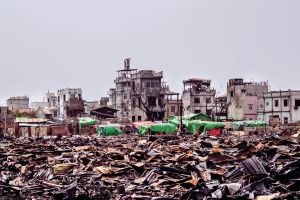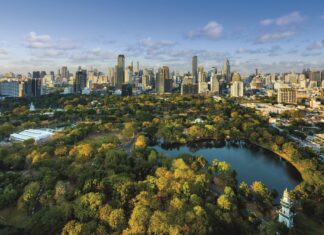Mooyoung Han explains how community-led rainwater innovations can be scaled to respond to the impacts of climate change.
In a world facing intensifying climate extremes, equitable and adaptive water solutions have become more urgent than ever. Rain for Resilience (R4R) is a global initiative designed to accelerate community-led rainwater innovations that enhance resilience, protect public health, and bridge the gap between local knowledge and global action.
Born from decades of field-based experience in rainwater harvesting, R4R brings together three proven models under one integrated framework:
- Community-Based Rainwater for Drinking systems for health protection and decentralised water access in schools, clinics and remote communities.
- The Rain School Initiative, which empowers youth through hands-on, climate-conscious education.
- The Mountain Rehydration Movement, which restores soil moisture in upland forests through micro-scale rainwater traps, offering a natural line of defence against drought and wildfires.

These innovations have been tested and scaled in diverse settings – from Cambodian classrooms to earthquake-affected villages in Myanmar – but they all share a common approach: simplicity, local ownership, and the transformative power of rain.
Sustainable solutions
R4R aligns with the UN’s call for nature-based and inclusive solutions to climate and water challenges. The R4R concept will be further elevated through two international platforms: the IWA Rainwater Harvesting and Management Conference in Phnom Phen, Cambodia, on 1-6 September 2026, and the UN 2026 Water Conference, co-hosted by the United Arab Emirates (UAE) and Senegal, and convened in the UAE on 2-4 December 2026. These venues offer timely opportunities to assemble practitioners, researchers and policymakers around community-based rainwater resilience.
To support this engagement, a ‘Rain for Resilience Declaration’ is being drafted, calling on governments and institutions to: recognise rainwater as a viable source of safe drinking water; invest in local rainwater infrastructure for climate adaptation; integrate rainwater literacy into formal education systems; share knowledge and technologies across borders through open partnerships; and designate a UN Rainwater Day to elevate rainwater harvesting as a global climate solution.
This declaration will serve not only as a call to action, but also as a collaborative roadmap for scaling up localised solutions in a global context.
The R4R initiative also benefits from the growing recognition of its founding partners. Most recently, Rain for All, one of the organisations behind R4R, contributed a key message to world leaders in the official 2026 UN Water Conference stakeholder consultation report – highlighting rainwater harvesting as a community-driven solution for water resilience and climate adaptation.
Together, these models challenge conventional boundaries of water management – reaching beyond pipes and pumps to embrace education, emergency response, and even ecosystem-based resilience in vulnerable mountain landscapes.
Every drop is local, but turning rain into resilience takes global action. By lifting the simple act of harvesting rain – from rooftops to ridgelines – R4R aims to reframe water security as a shared responsibility rooted in community agency and environmental care.
As the climate crisis deepens, let us remember – resilience is not built by leaders alone, but in the hands of those who catch the first drop.
The author: Mooyoung Han is Professor Emeritus of Civil and Environmental Engineering at Seoul National University, and Director of Rain for All (UN ECOSOC-Accredited NGO) and Chair, IWA Rainwater Harvesting and Management Specialist Group
Sky’s mercy – A community rainwater system for disaster recovery in Myanmar

When a 7.7 magnitude earthquake struck Myanmar on 28 March 2025, more than 17 million people across 13 states and regions were left vulnerable – not just to structural damage, but to the sudden collapse of water systems. Centralised infrastructure failed, bottled water became scarce, and public health risks mounted.
From this urgency the Mobile Rainwater for Drinking (RFD) system emerged – a decentralised, portable rainwater harvesting solution designed for post-disaster contexts. The system connects five tanks in series, each facilitating sedimentation and natural purification, eliminating the need for electricity or chemicals. A collapsible catchment surface can be quickly assembled and disassembled, allowing even non-technical community members – and women, in particular – to operate it independently.
In May 2025, a pilot was conducted in an earthquake-affected village in Myanmar. With just 32 mm of rainfall, the Mobile RFD collected more than 500 litres of usable water. Local women managed the setup and water handling after brief instruction, highlighting the system’s simplicity and potential for community ownership.
The innovation was formally presented at the Mekong-Republic of Korea Cooperation Forum on 14 May, in Hanoi, Vietnam, where it drew interest from policymakers and practitioners from Cambodia, Vietnam, Laos, Thailand, and beyond. A senior official from Myanmar’s Ministry of Foreign Affairs received briefing materials and expressed support for pilot expansion. The system also gained visibility among attendees from Korea’s Ministry of Foreign Affairs, the Global Green Growth Institute, Indonesia, and the United Nations Development Programme.
More than a technical fix, Mobile RFD offers a platform for gender inclusion, youth engagement, and low-cost resilience. It serves as a teaching tool in Rain School programmes, where students learn to monitor water quality, record rainfall and engage with climate science. It aligns with Sustainable Development Goals (SDGs) – from clean water (SDG 6) and good health (SDG 3) to gender equality (SDG 5) and climate adaptation (SDG 13).
The system’s structure is simple: five tanks, basic piping, a foldable rooftop, and no need for power. Yet its impact is complex and profound – a locally managed, scalable, nature-based solution to an escalating global challenge.
At a time when climate disasters are increasing in frequency and intensity, Mobile RFD reminds us that resilience can come from above. In Myanmar, the sky’s mercy is being stored, purified and shared – one drop, one tank, and one community at a time.








